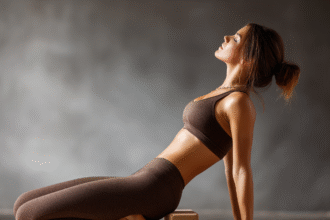I never thought much about it.
I would sit down at my desk with electrolyte-rich water, open my laptop, and before I knew it, hours had passed — meetings, writing, emails, planning. I would look up and realize the day was nearly over, and I had barely moved, except for lunch, which was often under 30 minutes on busy days.
Like many people, I spend most of my day in front of a screen. And while I’ve always prioritized health in other areas of life — nutrition, sleep, pilates, mindfulness — this one slipped through the cracks.
Then my body started whispering.
First, it was a dull ache in my lower back. Then tightness down one leg. Eventually, I noticed I had developed a habit of crossing my legs while sitting — for hours. That compressed position was quietly wreaking havoc on my sciatic nerve and blood circulation.
I didn’t want to ignore it, and I definitely didn’t want to take painkillers and push through. That has never been my way. My instinct is always to find the root cause, not just a quick fix. So I started researching.
And what I found was eye-opening.
The Truth About Sitting All Day
We’ve all heard the phrase “sitting is the new smoking,” so it was the time to look into this. Prolonged sitting has been linked to:
- Poor blood circulation often results in an increased risk of blood clots
- Lower back pain and compressed nerves – sciatic tension
- Reduced metabolism and greater risk of weight gain
- Weakened core and postural imbalance
- Increased risk of some chronic diseases, including heart disease and type 2 diabetes
- Decreased focus and mental energy
The problem isn’t just sitting; it’s the duration and lack of active movement or postural variation. Our bodies weren’t designed for hours of sedentary stillness.
So I made a shift.
What I Did: The Standing Desk Changed Everything
The first thing I did was invest in a standing desk. This step was about having flexibility and alignment in my workday.
Now, I spend about 70–80% of my day working at a standing desk. I bring my laptop to the floating, small desk for most tasks and only use my sitting desk when I need to work on a larger screen or in a quiet, focused corner for deep work.
Even then, I’ve started considering switching to a larger standing desk setup at home that can support my ultra-wide monitor so I don’t default to hours of passive sitting again. I can spend hours writing articles, and when I am lost in creative projects, I can easily lose track of time.
This one change — one intentional shift in my environment — dramatically reduced my lower back pain, improved my focus, and reminded me to take better care of my body while continuing to do the work I love.
I move more throughout the day. I feel more energized and alert. And most importantly, I no longer ignore the signals my body sends me.
Why You Might Want to Rethink Your Desk Setup
If you work long hours at a desk, your body may be quietly absorbing the consequences. Even if you exercise regularly, the extended sitting time can offset many of those benefits. A standing desk won’t fix everything, but it’s a powerful start because most of us spend hours at a desk — this is a tangible way to realign your workspace with your well-being.
The goal isn’t to stand all day — it’s to move, alternate, and stay aware.
Here Are My Standing Desk Picks Based on Work Style
Floating Standing Desk – Perfect if you move between spaces. Light, portable, and instantly creates a standing setup anywhere. I have one in my office.
Sleek Standing Desk for Ultra-Wide Screens – A more stable, spacious option if you use large monitors or multiple screens. Great for creatives and power users. I am considering this for my home office.
Elegant Standing Desk for Any Decor – If aesthetics matter to you (they do to me), this is a beautiful piece that elevates both form and function in your office.
Elegant tools = elevated habits. You don’t have to sacrifice beauty for ergonomics.







